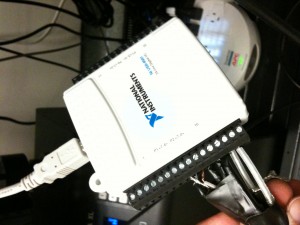So a while back I cooked up an overview of how to control TTL devices using elements, meta or other software through the parallel port. With the release of 64-Bit version of Windows, it’s become obvious that Microsoft will allow the venerable parallel port to die off, via a lack of low level driver support. Now the parallel port was already on a path to demise, as it’s simple 5v on/off state and a lack of discreet control was a hindrance, not to mention the requirement to either custom pin a cable or chop up a perfectly good cable, figure out which wires went where, and then harvest the lines needed.

For people new to the industry or new to high speed device control, here is why you use these older types of comm methods:
- No specific driver implementation is needed, causing your software to remain functional for long periods of time, along with items such as firmware updates that affect serially controlled devices to be a non-issue.
- Speed is higher due to the lack of a logic processor needing to chew on ascii or other commands sent from a computer.
- Many devices, even today, only operate on TTL or +/-v. For these device manufacturers they avoid the need for extensive driver dev and support, while ensuring wide compatibility with software. So it’s kind of a win for the user, device manufacturer and software developer.
TTL
In a nutshell, TTL is a light switch. The software from the PC sends out either 0 volts signal (off) or +/-5v (on). This switch can be connected to things like shutters, laser launches, diodes, cameras or any other device that accepts an on/off or run/stop input.
Analog Voltage out (DAC)
Analog control is used to control a device over a voltage range. A common example is a piezo motor. In this example the motor may be at position 00 um, when voltage = 0v. As the voltage is increased, in small amounts, to say +10v, the piezo focusing motor correspondingly adjusts to it’s maximum travel, of say 100um.
So, after some searching I’ve found a few solutions that will work.
#1. National Instruments USB-6008.
This nifty little usb box provides 2 analog outputs with -5 to +5 voltage range (I am working on a way to up-convert these for use as 10v systems), 12 bi-directional channels (can be used either for input OR output), and all of this is in a canned, easily connected package for a list of $169. This is a major bang for the buck, as a high quality PCI to parallel port is $130! Not to mention the other PCI-based products from NI, which usually run in the $1,500+ range. A few other notes:
- I have run this box in Metamorph, win7 x64 and it works correctly.
- I have run this box in Elements, win7 x64 and it runs correctly.
#2. Measurement Computing Minilab 1008
Measurement computing still provides it’s convenient multi-i/o breakout system called the mini-lab 1008. This box is a nice bench test/control system to have around if you work with any TTL or Voltage devices. The one problem currently is that this box does not support native win64 drivers. The 32 bit DLL will work with the device itself in win7x64, but programs that are x64 native will not talk properly to the 32 bit DLL. So, for our type of work this is on hiatus until they provide a x64 driver that is fully compatible. A few notes:
- I have not personally been able to get my 1008 working.
- MCC says they are working on a driver, but I haven’t tried to DL the newest ones lately, this may be a resolved issue, however I can’t confirm this right now.
#3. National instruments USB-6501
This is a box similar to the above 6008, however this box only provides +/-5v TTL. No analog adjustable control is supported on this product. I have installed and worked with one of these and it’s an easy system to work with. Similar to the unit above, but you save $40 for the lack of analog voltage control, for a list price of $99.
Hopefully this will help you in your efforts to control so many of our devices using new x64 operating systems!
– Austin
Comments
2 responses to “More on Device control via TTL, Voltage and the death of the parallel port”
[…] posted briefly about this a while back, in my explanation of the demise of the parallel port. I finally got my hands on a National Instruments USB-6008 box, and have found the unit to be 100% […]
[…] it makes control from a computer very straightforward. If you have a printer port, or if you have a National Instruments style TTL Box, you can simply attach a BNC connecting cable to the back of the TLED Control unit, and the lamp […]